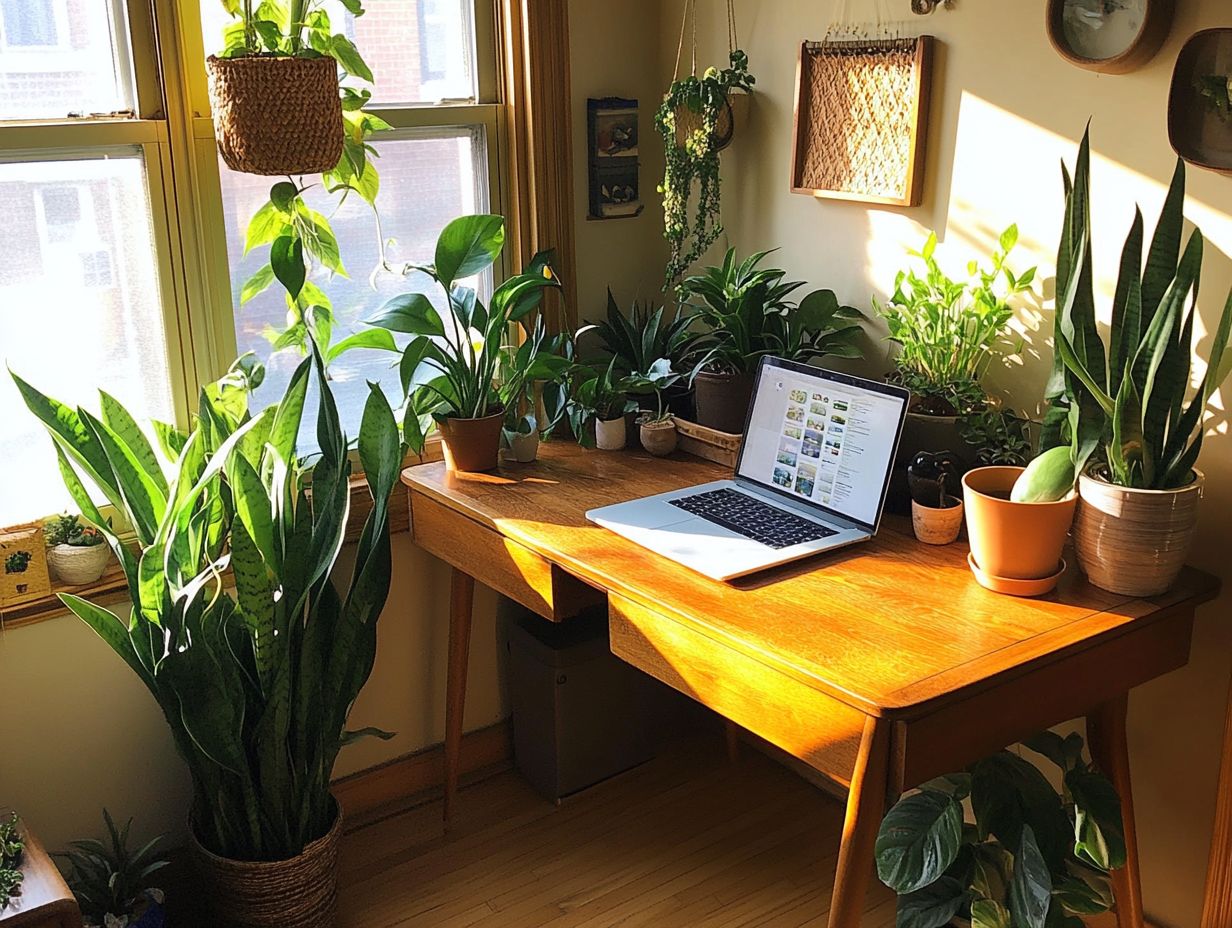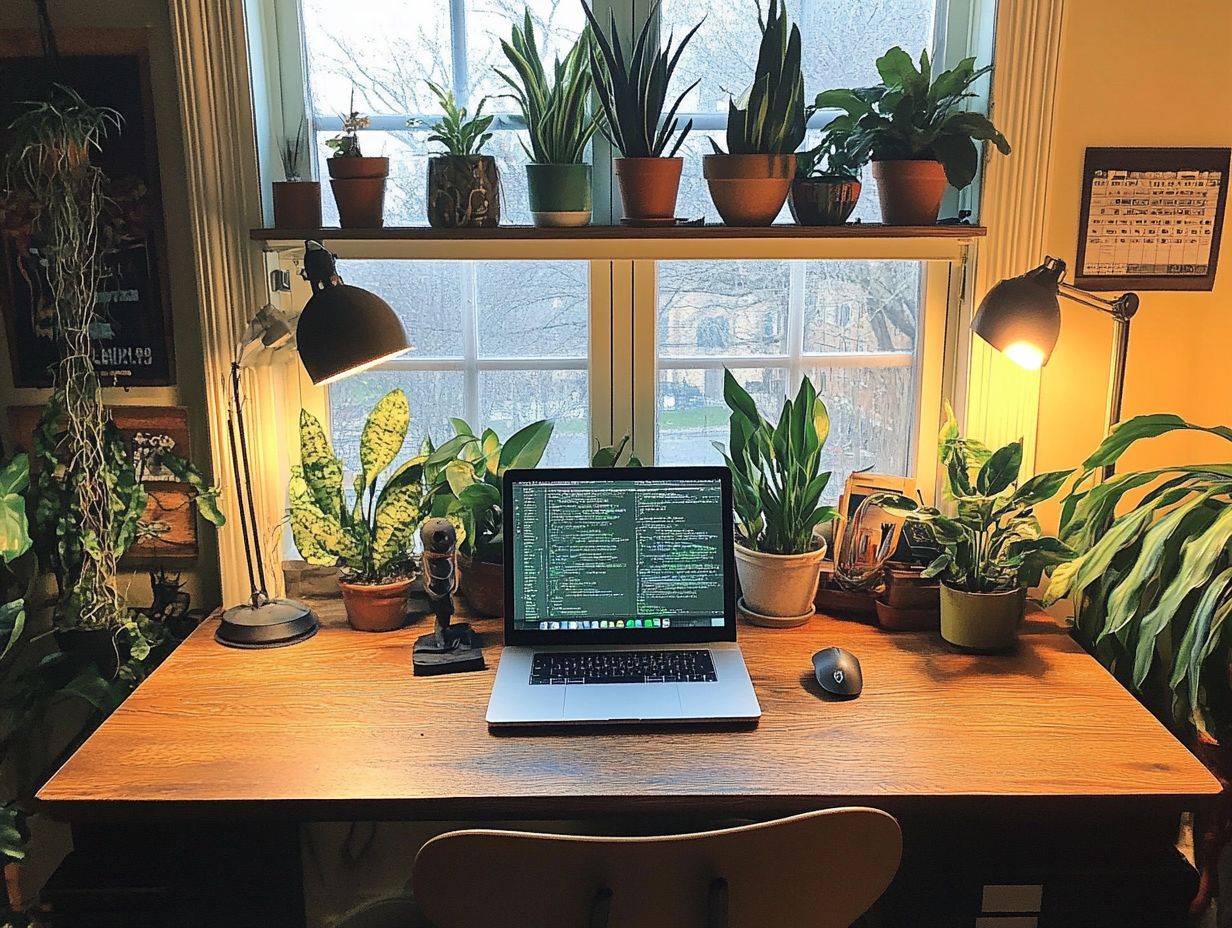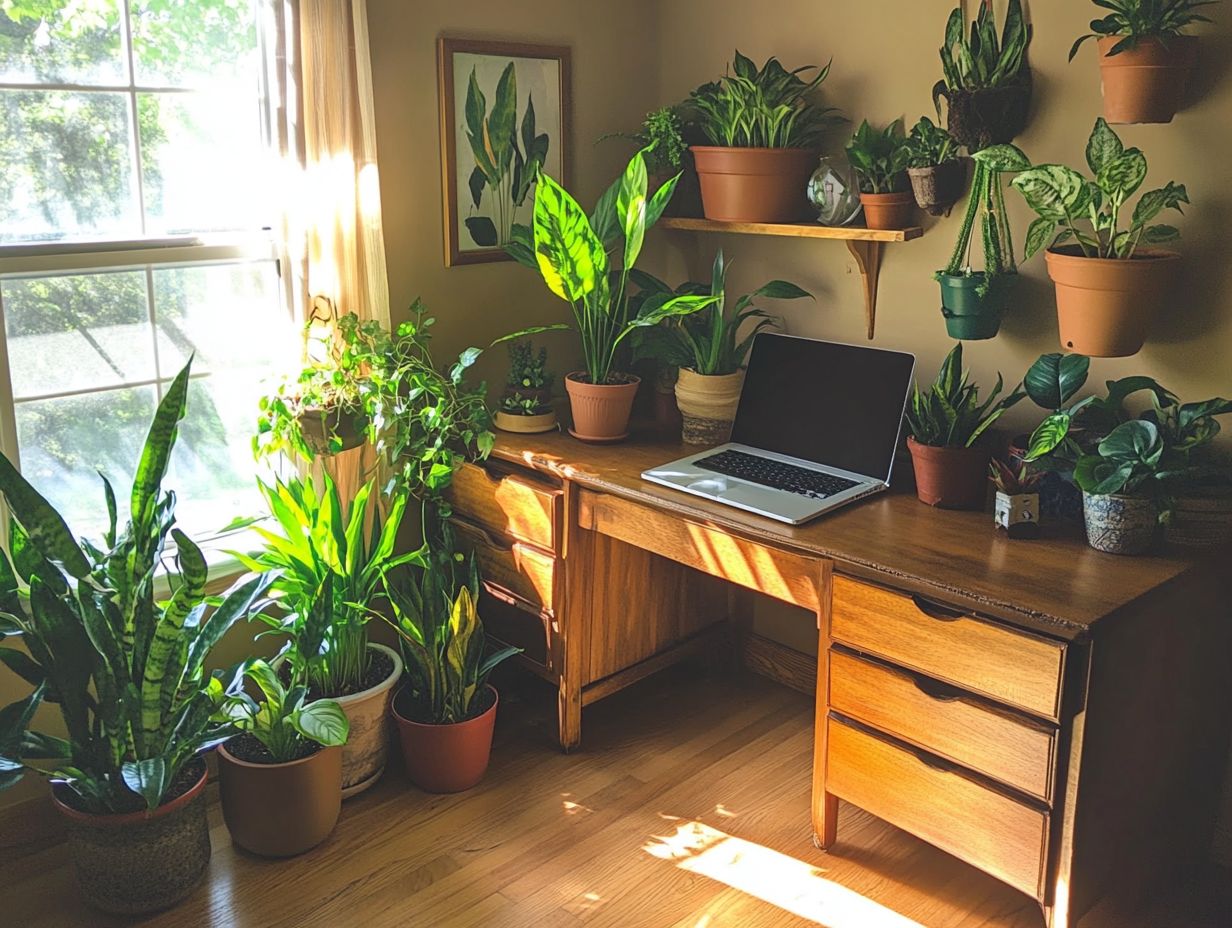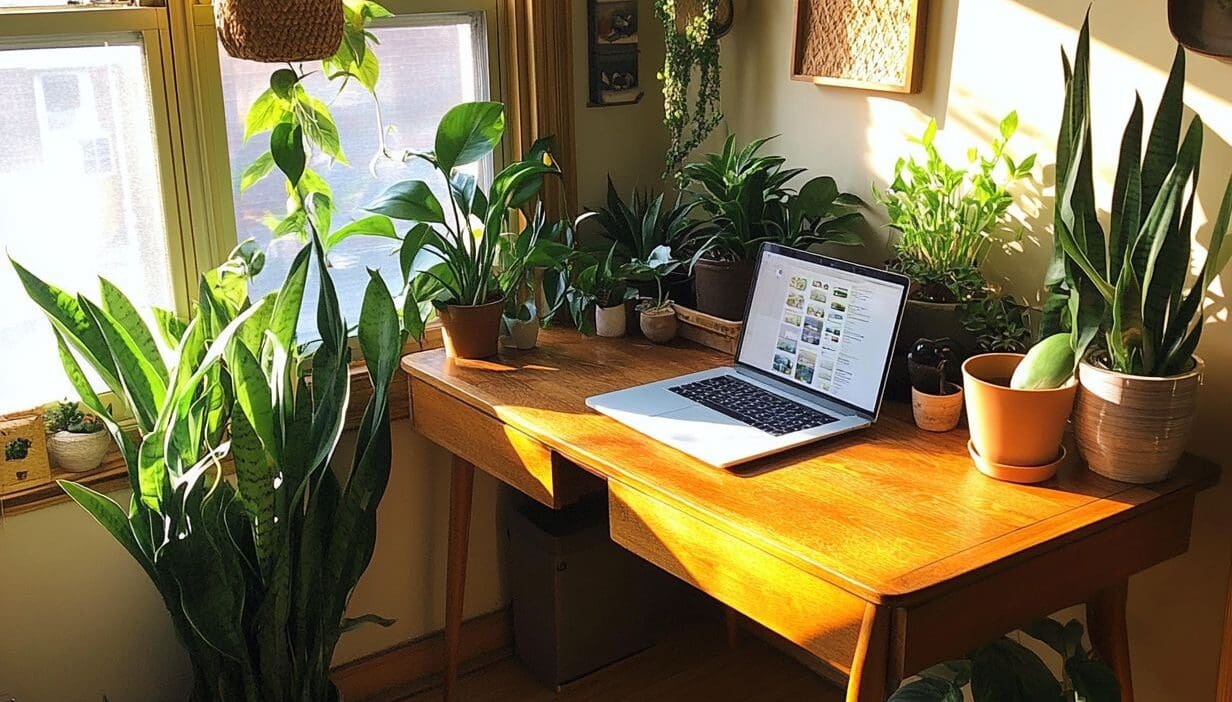In today’s fast-paced work environment, the emphasis on productivity frequently overlooks a crucial factor: the power of nature. Incorporating indoor plants, such as the ZZ Plant and Peace Lily, into the workspace can significantly enhance productivity and overall well-being. Beyond serving as mere decorative elements, plants improve air quality, like the Spider Plant and Aloe Vera, and stimulate creativity, making them essential contributors to a healthier work atmosphere. This article examines the benefits of indoor plants, including low maintenance options like succulents and Chinese Evergreen, offers guidance on selecting the appropriate plant types for your specific environment, and provides essential plant care instructions to ensure their continued vitality, thereby creating a workspace that is both vibrant and inspiring.
Key Takeaways:
Benefits of Indoor Plants in the Workspace

In the contemporary, fast-paced work environment, the integration of indoor plants into the workspace presents numerous advantages that significantly enhance employee well-being and productivity.
A variety of office plants, such as the widely recognized Peace Lily, Snake Plant, and ZZ Plant, not only improve the aesthetic appeal of the office environment but also play a crucial role in air purification and stress reduction. These claims are supported by respected studies like NASA’s Clean Air Study, which highlights the air-purifying abilities of certain plants.
These plants contribute to creating a green workspace that promotes creativity and mitigates fatigue, making it essential for businesses to recognize the benefits of establishing a flourishing indoor plant ecosystem with varieties like the Parlor Palm and Cast Iron Plant.
How Plants Can Improve Productivity in the Office Environment
Research indicates that the presence of office plants can significantly enhance productivity by lowering stress levels and establishing a more inviting green workspace.
Numerous studies have underscored the beneficial effects of greenery, such as the African Violet and Majesty Palm, on employee engagement and creativity. For example, the incorporation of succulents, like the Nerve Plant and Cactus, into workspace design has been associated with improvements in concentration and mood, effectively transforming a standard environment into one that encourages innovation.
Additionally, the widely recognized Ficus Benjamina not only contributes aesthetic value but also functions in air purification, thereby supporting cognitive performance. The psychological benefits of having office plants in the workplace are substantial, as they alleviate anxiety and foster a sense of well-being, allowing employees to feel more connected to their environment. For those interested in a comprehensive overview, this analysis by Healthline covers the full spectrum of the benefits of indoor plants.
Consequently, introducing nature into indoor spaces is not merely a trend; it represents a strategic initiative aimed at cultivating a more productive workplace atmosphere.
Other Benefits for Health and Well-being
Indoor plants offer a range of health benefits, including enhanced air purification, reduced stress levels, and improved humidity levels, all of which contribute to overall well-being within the office environment.
For example, the Snake Plant is recognized for its ability to filter toxins such as formaldehyde and benzene, thereby not only improving air quality but also fostering a sense of tranquility. Similarly, the Peace Lily is esteemed for both its aesthetic appeal and its air-purifying properties, as it contributes to increased humidity levels, which can alleviate issues related to dry skin and respiratory discomfort.
Plus their physical benefits, these plants have been shown to elevate mood and cognitive function, thereby reducing anxiety and promoting a more productive workspace. According to Healthline, these science-backed benefits include factors such as improved air quality and enhanced well-being, further adding to their value in work environments.
As employees develop connections with these green companions, they may also experience enhanced creativity and improved focus, resulting in a healthier and more enjoyable work environment.
Choosing the Right Plants for Your Workspace

Choosing the appropriate indoor plants for a workspace is essential for achieving both aesthetic appeal and functional advantages, with options like the Money Tree and Philodendron.
Options include low-maintenance varieties such as the Snake Plant and ZZ Plant, as well as vibrant flowering plants like the Peace Lily. It is important to consider factors such as light conditions and available space in order to cultivate an optimal green workspace that can thrive in a busy office environment.
A comprehensive understanding of the various plant types and their specific requirements can contribute to a healthier and more productive atmosphere.
Considerations for Light and Space
When selecting indoor plants for a workspace, it is crucial to assess the available light and space, as different plants have distinct light requirements and growth characteristics.
For example, succulents and cacti flourish in areas with ample natural light, exhibiting vibrant colors and significant growth when situated near windows. Conversely, individuals working in windowless offices may prefer low-light species, such as snake plants or pothos, which can thrive in subdued conditions while enhancing the overall atmosphere of a creative workspace.
By comprehending these differences, individuals can make informed choices regarding the types of plants, like the Dracaena and English Ivy, to incorporate into their environment. This, in turn, can improve air quality, increase productivity, and create a more inviting workspace.
Low Maintenance Options
For busy professionals, selecting low-maintenance indoor plants can streamline plant care while still offering aesthetic appeal and health benefits. Popular options include the ZZ Plant, Snake Plant, and various drought-tolerant succulents, all of which exhibit resilience.
These plants thrive with minimal care, requiring infrequent watering schedules—typically only once every few weeks. With a high tolerance for indoor humidity levels and suboptimal lighting conditions, they are particularly suitable for office environments and residences that may lack ample natural light.
The Snake Plant, for instance, not only purifies the air but also adapts well to a wide range of temperatures. Likewise, the ZZ Plant features glossy leaves that add a touch of elegance while demanding very little maintenance.
By incorporating such plants into their surroundings, individuals can enhance their environment with vibrant aesthetics without the burden of extensive upkeep.
Caring for Indoor Plants

Caring for indoor plants requires a thorough understanding of their specific needs, including appropriate watering schedules, humidity levels, and general plant care practices, especially for plants like the Rex Begonia and Umbrella Tree.
These factors are essential for maintaining a healthy and vibrant green workspace within an office environment.
Essential Care Tips
To ensure the optimal growth of office plants, it is essential to adhere to fundamental care guidelines, including the establishment of a suitable watering schedule and the maintenance of appropriate humidity levels.
Plus these foundational practices, it is imperative to regularly evaluate the specific environmental conditions within the workspace, such as light intensity and temperature fluctuations. Different plants exhibit distinct light requirements; some may thrive in bright, indirect sunlight, while others are better suited for low-light conditions.
By monitoring these factors, one can make timely adjustments in the placement of plants to promote optimal growth.
Maintaining a consistent humidity level is particularly important in arid office environments, which can be effectively managed through regular misting or the implementation of a humidifier, ensuring the longevity of plants like the Majesty Palm and ZZ Plant.
By remaining attentive to these details, plant care routines can be customized, ensuring that each indoor plant not only survives but also flourishes.
Best Indoor Plants for a Productive Workspace
Selecting the most suitable indoor plants for a productive workspace can significantly enhance air quality, boost productivity, and improve overall mood.
Among the popular options are the Peace Lily, recognized for its air-purifying qualities, and the Snake Plant, valued for its low maintenance requirements.
Plants That Improve Air Quality in the Office Environment

Certain indoor plants, including the Peace Lily, Snake Plant, and ZZ Plant, are widely recognized for their exceptional air purification properties, making them excellent selections for improving indoor air quality in the workplace.
These plants not only contribute aesthetic value but also play an essential role in filtering out harmful toxins such as formaldehyde, benzene, and trichloroethylene. Research conducted by NASA in the late 1980s demonstrated that specific houseplants can remove up to 87% of indoor air pollutants within a 24-hour period.
By integrating these plants into the office environment, individuals may experience a reduction in fatigue, enhanced focus, and an overall improvement in well-being.
Furthermore, a study published in the Journal of Physiological Anthropology indicates that interaction with indoor plants can decrease stress levels and elevate mood, highlighting how the simple inclusion of greenery, such as the Chinese Evergreen and Parlor Palm, can significantly transform indoor workspaces into healthier and more productive environments.
Plants That Boost Mood and Creativity
Incorporating indoor plants into the workspace can significantly enhance mood and creativity, fostering a greener and more inviting environment that promotes innovation and collaboration.
Research has demonstrated that the presence of plants not only purifies the air but also contributes to the reduction of stress and anxiety, which in turn leads to improved focus and productivity. For instance, a study conducted by the University of Exeter found that employees who worked in environments enriched with greenery reported higher levels of well-being and job satisfaction.
Certain plants, such as the peace lily and the spider plant, are recognized for their air-purifying properties, which can enhance cognitive function and facilitate clearer thinking. Additionally, anecdotal evidence suggests that surrounding oneself with vibrant, living plants stimulates the senses, thereby fostering creativity and providing a necessary mental respite during intensive work sessions.
Plants That Enhance Focus and Concentration
Certain indoor plants like the Snake Plant and Succulents have been shown to enhance focus and concentration, which are critical components for productivity increase in a demanding office environment.
Research has indicated that incorporating specific types of greenery, such as succulents and peace lilies, can significantly improve cognitive function. Studies reveal that having plants within view reduces stress levels and can lead to enhanced mental clarity.
For example, a study published in the Journal of Experimental Psychology highlighted that individuals with plants in their workspaces reported elevated levels of concentration and reduced fatigue. This finding aligns with expert opinions that suggest the presence of such flora not only enhances the aesthetic appeal of a space but also provides crucial air purification benefits, contributing to a healthier and more inviting environment that promotes productivity.



